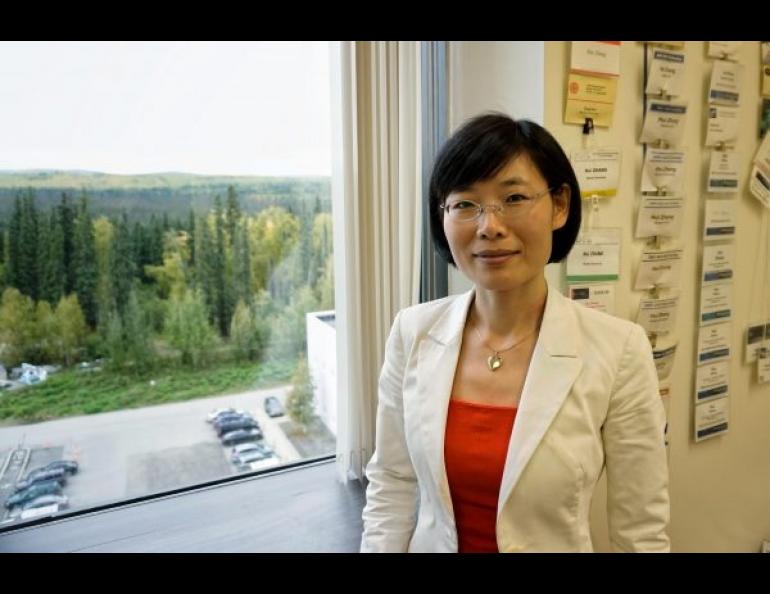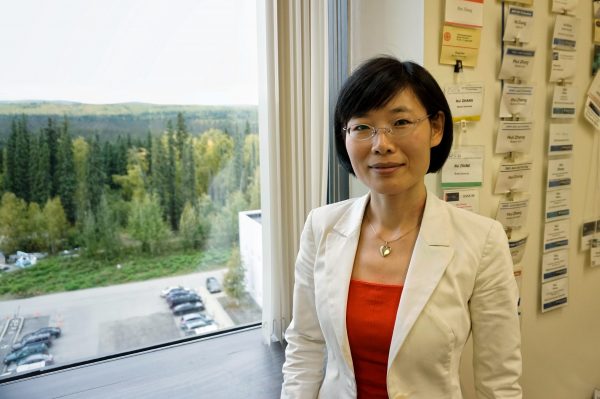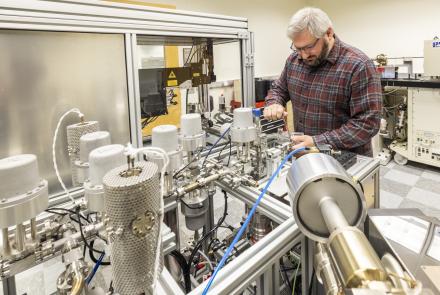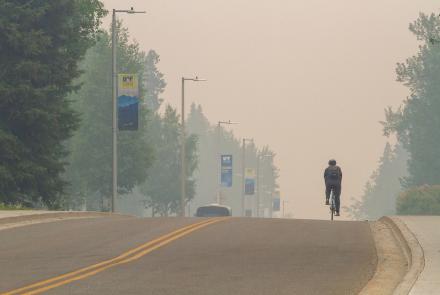
Focus on physics defines Zhang’s career journey
Deep inside the University of Alaska Fairbanks’ Geophysical Institute is Hui Zhang’s office. The building’s air ventilation system fills the room with a dull hum and three desks line the mostly bare, white walls. Behind the door a large bookshelf holds scientific papers, textbooks and journal publications.
The walls are filled with 38 conference badges hanging in a few orderly columns with many more in a pile on a nearby desk. The only other items are a topographical map of Alaska, postcards from places that Zhang has visited and a NASA-themed calendar featuring rainfall charts.
The barren appearance of her office would not lead someone to conclude that she had been there for five years, but dressing it up has never been a priority.
“I just don’t have time to decorate,” said Zhang, a professor of physics and geophysical scientist.
Zhang, who works as many as 100 hours per week, spends her time analyzing data about the connection of the Earth’s magnetic field to the magnetic field of solar wind. The sun constantly emits charged particles that create their own magnetic field. When the sun throws these particles toward the Earth, their magnetic field connects to Earth’s magnetic field and creates the aurora.
For example, in late autumn of 1859, a brilliant crimson light filled the sky as far south as Hawaii and Italy. This phenomenon, called the aurora borealis, was a result of a massive ejection of charged particles released from the sun, creating a geomagnetic storm. It shorted out telegraph wires across the United States and Europe when the electrical current coming through the atmosphere overloaded the circuits powering the telegraph wires.
Zhang studies these geomagnetic storms. She was born in Qing Dao, a large city on the eastern coast of China, in 1979, and started her long career with physics at age 12 when she was first introduced to the discipline.
“Even when I was very young I thought I would either be a scientist or a teacher,” Zhang said. “So now I’m both.”
In her last year of high school she took the National Higher Education Entrance Examination and earned a score that got her accepted into Peking University in Beijing, one of the best universities in China. Zhang took all of the physics classes available, along with computer science and English classes. She did not have time to do much in college besides her course work, but she did join an astronomy club.
“She concentrated herself to her major, astrophysics, which is a difficult and complex subject,” said Xiaona Chen, a friend since their high school days together in China. “She learns all the major lessons well, and has taken the first place in her class during the four years of study in Peking University. Many classmates admired her.”
In 2002, Zhang moved to the United States to get a doctorate in astronomy at Boston University.
“Everything is different, everything is new to me,” Zhang said about the U.S. “It was very exciting.”
Her transition was difficult for the first few months, but Zhang was able to quickly get used to her new environment. In China, she and her classmates learned English, but it was rare for them to talk with native speakers, so they sometimes had trouble speaking or comprehending the new language.
“I went to the lectures and I could only understand about 30 percent (of the lecture] on the first day,” Zhang said.
At Boston University she studied a region of the magnetic sphere called the “cusp region.” For this research she analyzed data from Cluster, a set of four satellites launched by the European Space Agency that collect data about Earth’s magnetosphere.
After she completed her degree she was accepted to NASA’s Goddard Institute for Space Studies. She only worked there for two years before being offered a job at UAF as a research professor. Zhang made the decision to come to Fairbanks because she was offered a tenure track position.
“When we did the search for this position, because the field is small you have a very limited number of applicants,” said UAF physics professor Antonius Otto, who met Zhang in Boston. “I told everybody that we were extremely lucky to have her as an applicant and to have her accept the position here.”
“She has come to Fairbanks at a relatively young age and has already made quite an impact in the Physics Department and our research field,” Otto said.
Zhang said UAF is an attractive destination for space scientists. The Geophysical Institute has Poker Flat Research Range, the largest land-based rocket range in the world and the only high-latitude range in the U.S., and Zhang also valued the ability to view the aurora personally.
The offer from UAF was one of the most exciting moments of her life, she said.
“I came here for an interview in March and I saw some people walking around campus wearing shorts,” Zhang said. “I thought ‘Wow, Fairbanks is so different from anywhere else.’”
Zhang still collaborates with scientists at NASA. In spring 2017, she spent her sabbatical studying how solar wind interacts with the Earth’s magnetosphere during the day using data from NASA’s Magnetospheric Multiscale mission.
Zhang tries to keep in touch with her life back in China. She calls her parents weekly and goes to China about once a year to see friends and family, and to collaborate with other scientists.
“We often write emails with each other — sharing our experience, happiness or sadness,” said Chen, her friend.
While her plan has been clear up to this point in her life, Zhang is not sure about what her long-term future holds.
Zhang said she’ll stay in academics and hopes to work with an even larger research group. Working with the graduate students is a favorite part of her job.
“Hui loves her research,” Chen said. “When you first meet her, you may think she is quiet, not good at talking. But if you talk her research work with her, her eyes will sparkle, and tell you many things.”
Sue Mitchell, University of Alaska Fairbanks Geophysical Institute, 907-474-5823, sue.mitchell@alaska.edu






